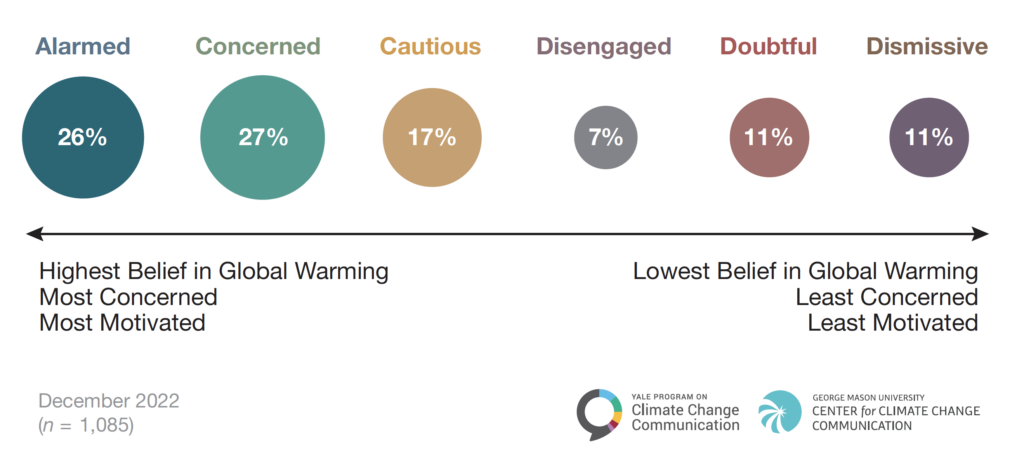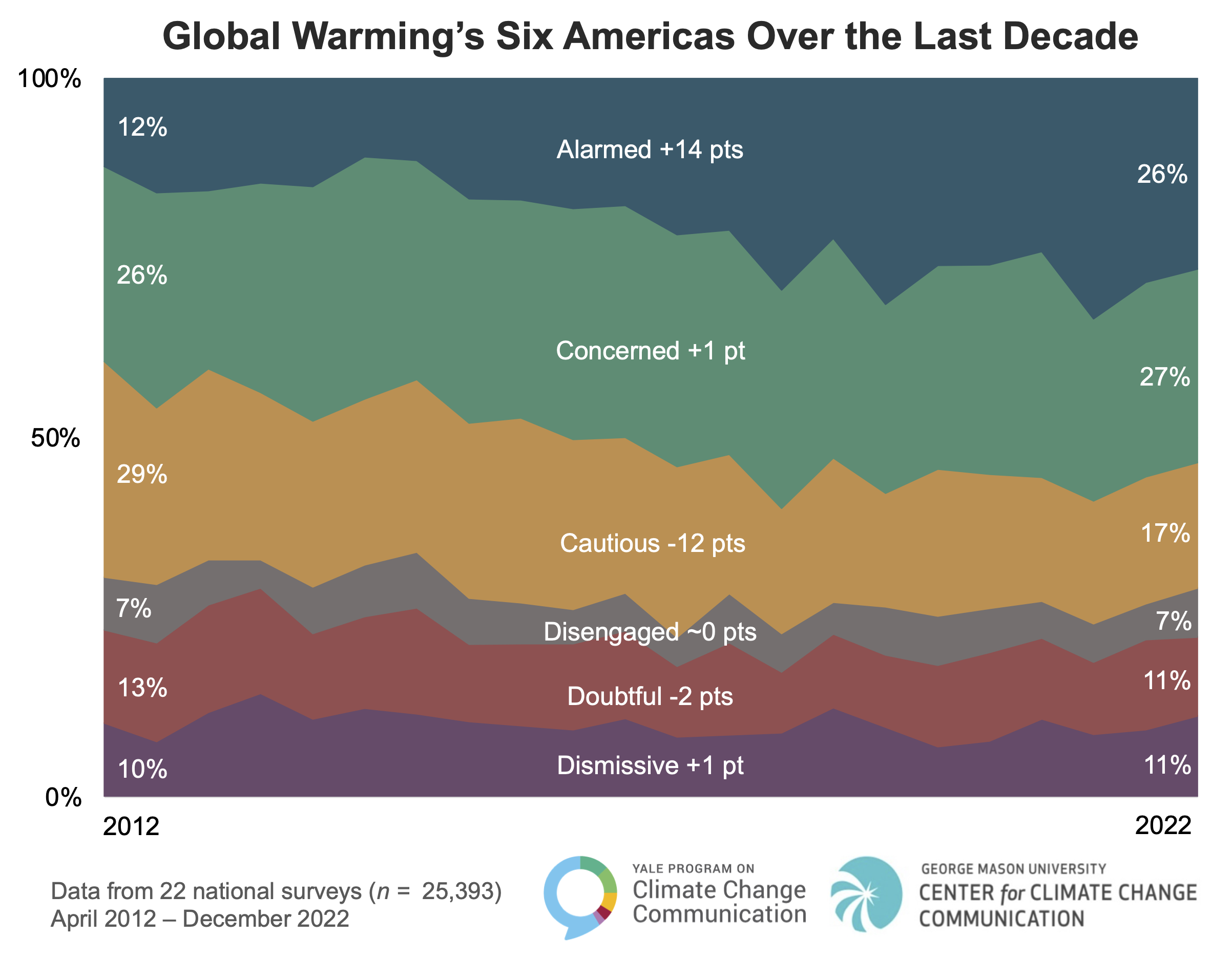Climate Note · Mar 14, 2023
Global Warming’s Six Americas, December 2022
By Anthony Leiserowitz, Edward Maibach, Seth Rosenthal, John Kotcher, Matthew Ballew, Jennifer Marlon, Jennifer Carman, Marija Verner, Sanguk Lee, Teresa Myers and Matthew Goldberg
Filed under: Audiences and Beliefs & Attitudes
In 2009, we identified six distinct climate opinion audiences within the American public – the Alarmed, Concerned, Cautious, Disengaged, Doubtful, and Dismissive – Global Warming’s Six Americas. The Alarmed are the most engaged with global warming: they are convinced it is happening and human-caused, are very worried about it, and strongly support climate action. The Concerned are also convinced global warming is happening and human-caused, but they worry about it less and are less motivated to take action. The Cautious are uncertain about whether or not global warming is happening and human-caused, and are not very worried about it, so they are less motivated to act. The Disengaged are largely unaware of global warming. The Doubtful question whether global warming is happening or human-caused, and perceive it as a low risk, so they are among the least motivated to act. The Dismissive reject the idea that global warming is happening and human-caused, do not view it as a threat, and tend to strongly oppose climate policies.
Most recently, about 1 in 4 (26%) Americans are Alarmed. They outnumber the Dismissive (11%) by more than 2 to 1. Since our last Six Americas report, the Alarmed segment has decreased by 7 percentage points (from 33% in September 2021), however, the majority of Americans (53%) are still either Alarmed or Concerned, while fewer than half that number (22%) are either Doubtful or Dismissive.
The Six Americas Over the Last Decade
Since 2012, the Alarmed segment has more than doubled in size, growing from 12% of the U.S. population in 2012 to 26% in 2022 (+14 percentage points). The Alarmed segment is now similar in size to the Concerned (27%). Conversely, the Cautious segment has decreased in size from 29% in 2012 to 17% in 2022 (-12 percentage points). The Concerned, Disengaged, Doubtful, and Dismissive segments have remained relatively similar in size over the last decade.
Communication Challenges and Opportunities
The increase in the number of Alarmed Americans tracks closely with the increase in the percentage of Americans who understand that global warming is a present-day problem that is already harming communities across the nation. In other words, Americans are increasingly coming to understand that climate change impacts are happening here and now.
It remains important to continue to communicate with the public about the many harms that climate change is already causing in American communities (e.g., health and economic impacts, damage to infrastructure from extreme weather). Our research has shown that many Americans trust NASA, climate scientists, TV weathercasters, their doctors, and a range of other experts for information on global warming. Additionally, most registered voters think schools should teach children about the causes, consequences, and potential solutions to global warming. Educators have key roles to play in helping Americans better understand the threats of and solutions to climate change.
Methods
These data are taken from the twice-yearly Climate Change in the American Mind survey, a nationally-representative survey of public opinion on climate change in the United States conducted by the Yale Program on Climate Change Communication and the George Mason University Center for Climate Change Communication. Surveys were conducted from April 2012 to December 2022 using the Ipsos KnowledgePanel®, a representative online panel of U.S. adults (18+). Respondents self-administered the questionnaires online in a web-based environment.
The average margin of error for each wave is +/- 3 percentage points at the 95% confidence level. Results are adjusted on a number of key demographic categories to align with U.S. Census parameters. Percentage points are rounded to the nearest whole number for tabulation purposes. As a result, percentages in a given figure or table may total slightly higher or lower than 100%.
Resources and Data
The Six Americas Survey (SASSY), a short, four-question online questionnaire, allows respondents to identify which segment they belong to (Chryst et al., 2018). Results also show how respondents’ views about global warming compare with the views of the U.S. population as a whole.
The SASSY Group tool allows users to upload their own data (e.g., from one’s own survey, a class, members of an organization, etc.). This tool determines the Six Americas segment for each person in the dataset and provides a downloadable spreadsheet and summary graphics.

